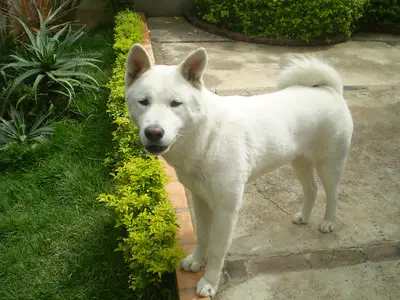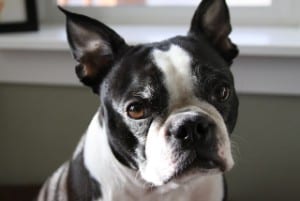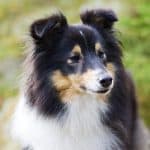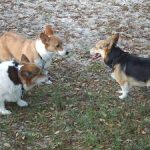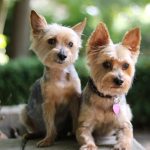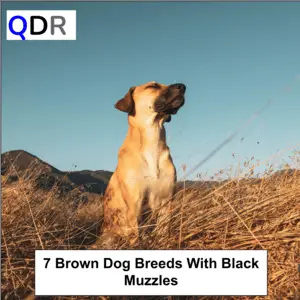
A dog’s muzzle, also called a snout, encompasses the nose, nostrils, and the surrounding area of the upper jaw and upper lip of a dog. Black muzzles are caused when the hairs on the muzzle are coloured by the eumelanin pigment which produces dark colour hair. Black muzzles on dogs are also called melanistic masks because a dog with a the black muzzle appears to be wearing a mask.
The colour brown has a large number of different shades stretching from the yellow and greens that are seen in the colour beige to the colour maroon with its strong hints of red. The same variety can be seen in the different shades of brown that can be seen in dog’s coats.
This article contains a list of 7 brown breeds of dogs with black muzzles – Black Mouth Curs, Bullmastiff, Pugs, German Shepherds, Leonburgers, Pekingese and Keeshonds. All of these breeds, except the Keeshond, can have brown coats.
What you will learn in this article:
7 breeds of dogs with black muzzles
1. Black Mouth Cur- best medium brown dog with a black face
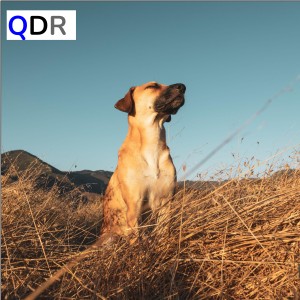
Black Mouth Curs are the first dog in our list of dogs with brown coats and black muzzles. Black Mouth Curs typically have a light brown coat and a black muzzle. In fact the black muzzle defines and names the breed. Their coats are very dense and smooth with short hair.
Black Mouth Curs trace their origins to the Southern United States, where they were initially bred for herding, guarding, and hunting purposes. This breed’s history reflects its versatility, excelling in various roles due to its intelligence and strength.
Temperament-wise, Black Mouth Curs are recognized for their courage, fearlessness, and high energy levels. They are particularly well-suited for guarding homes, herding livestock, and hunting game. With their intelligence, however, they demand consistent and vigorous daily exercise, approximately 1 to 1.5 hours.
While they display an affectionate nature towards family and children, supervision is advised due to their robust play style. Their protective instincts extend to children, sometimes leading them to intervene even in disciplinary actions.
Health-wise, Black Mouth Curs may be prone to conditions like hip dysplasia and ear infections.
2. Bullmastiff
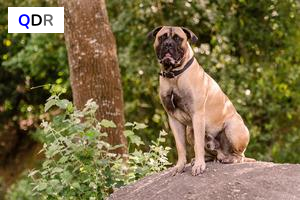
Bullmastiffs display a range of fur colors, including fawn, red, or brindle, and while black masks are common, not all Bullmastiffs have them. The American Kennel Club breed description for a Bullmastiff states that in order to recognised as a purebred dog, Bullmastiffs need to have a dark muzzle but not a black muzzle.
Adult males typically measure 25 to 27 inches (63.5 to 68.5 cm) at the shoulder, and adult females are slightly smaller. Males weigh between 110 to 130 lbs (50 to 59 kg), while females range from 100 to 120 lbs (45 to 54 kg).
The name “Bullmastiff” derives from the breed’s purpose: to guard estates and game preserves against poachers, combining the strength of a bulldog and the speed of a mastiff.
Bullmastiffs originated in 19th-century England, bred to tackle poaching issues on large estates. They were crossbred between Bulldogs and Mastiffs to create a powerful yet agile guardian.
Temperament-wise, Bullmastiffs are known for their gentle and loyal nature, making them excellent family protectors. They require moderate exercise, around 30 to 60 minutes daily, to maintain their health and prevent obesity.
Training Bullmastiffs is relatively straightforward. However, early socialization is crucial to manage their natural protective instincts.
Health-wise, Bullmastiffs may be prone to certain conditions, including hip dysplasia and certain heart issues. Monitoring their weight is essential to prevent strain on joints.
3. Pugs- best small brown dog with a black face
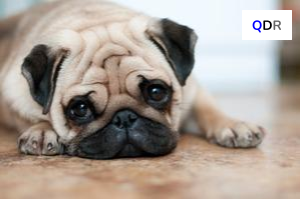
Next on our list of brown dogs with black muzzles are Pugs. Pugs boast distinctive, wrinkled faces and according to the AKC breed standard, a pug’s mask should be as black as possible. Their coats should either be fawn or black in colour.
Adult males measure around 12 to 14 inches (30 to 36 cm) at the shoulder, with females slightly smaller. Weight-wise, males typically range from 14 to 18 lbs (6.4 to 8.2 kg), while females weigh between 13 to 16 lbs (5.9 to 7.3 kg).
The name “Pug” is thought to originate from the Latin word “pugnus,” meaning fist, possibly referencing the breed’s clenched fist-like appearance or the Pug’s playful nature.
Pugs have a rich history, dating back to ancient China, where they were cherished companions to royalty.
Pugs are known for their friendly and affectionate nature, making them excellent companions for families and singles alike. They have moderate exercise needs, requiring about 30 to 45 minutes daily to keep them healthy and happy.
Pugs are quite easy to train although some Pugs may display a bit of stubbornness. This dog breed because of the shape of their face may be prone to a few respiratory issues and certain eye conditions.
4. German Shepherd
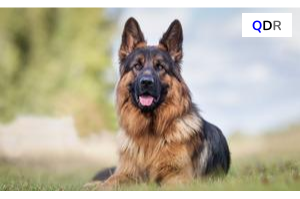
German Shepherds, which are also called Alsatians, are next on our list. Many German Shepherds have brown coats- some can be short haired whilst others are long haired. Other colour combinations for their coats are black and tan, sable or solid black. The AKC breed standard for German Shepherds doesn’t require them to have a black muzzle but it does require their heads to be as dark as possible.
Adult males typically measure 24 to 26 inches (61 to 66 cm) at the shoulder, with females slightly smaller. Males generally weigh between 65 to 90 lbs (29.5 to 40.8 kg), while females range from 50 to 70 lbs (22.7 to 31.8 kg).
The name “German Shepherd” reflects the breed’s German origins and its history as a herding and guarding dog. An alternative name for the breed is Alsatian, a term used in some regions.
German Shepherds have a rich history, originating in Germany in the late 19th century. They were initially bred for herding sheep, known for their intelligence and versatility. Their exceptional working abilities led to their widespread use in various roles, including police and military work.
Temperamentally, German Shepherds are known for their loyalty, intelligence, and versatility. They require about 1 to 2 hours of daily exercise to stay physically and mentally healthy. Training is typically straightforward due to their high intelligence and eagerness to please.
Health-wise, German Shepherds may be prone to hip dysplasia, elbow dysplasia, and certain genetic conditions. Regular veterinary check-ups and a balanced diet are essential for maintaining their overall well-being.
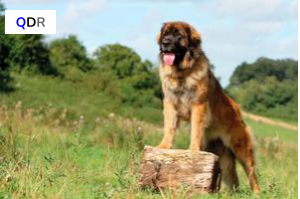
5. Leonberger- best large brown dog with a black face
Leonburgers are sixth on our list of brown dogs with black faces. The AKC breed standard requires that a Leonburger should always have a black mask which covers their faces. Leonbergers have an amazing array of coat colours- anywhere from “lion yellow”, to sand and gold and a red brown. Like lions, they’re known to be aristocratic and graceful. In these dogs, the melanistic mask usually covers their whole face, as well as part of their neck.
Out of all the dogs in this list, Leonbergers are perhaps the most trainable dog breed. Training them well is essential while they’re growing up. Fully grown Leonbergers are stronger than, and can outweigh, most dog owners. They’re known to be rather stubborn if they’re not trained properly as pups.
Leonbergers need daily exercise, but not an excessive amount, just 20 minutes of exercise a day will be enough to keep them happy and healthy. They also need a lot of socialization with people so the more time you spend with them, the more they’ll love you!
6. Pekingese
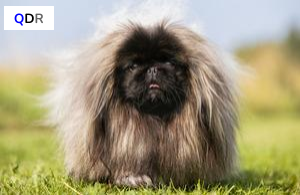
Last on our list are Pekingese. Pekingese are known for their distinctive, flat faces and prominent, dark eyes. Black masks are common on Pekingese but this isn’t a requirement of the AKC breed standard. Many Pekingese have coats that are different shades of brown. But all coat colours are acceptable and so some Pekingese will have a black coat, others will have a white coat.
Adult males measure about 6 to 9 inches (15 to 23 cm) at the shoulder, with females slightly smaller. Males typically weigh between 8 to 10 pounds (3.6 to 4.5 kg), while females range from 6 to 8 pounds (2.7 to 3.6 kg).
The name “Pekingese” reflects the breed’s association with ancient Peking City, now Beijing. An alternative name for them is “Lion Dog,” highlighting their resemblance to Chinese guardian lions.
Pekingese have a rich history, originating in ancient China, where they were favored by Chinese royalty. Bred to resemble Foo Dogs, they were symbols of regality, and commoners faced death penalties for owning one.
Temperamentally, Pekingese are known for their affectionate and regal demeanor. They require about 30 minutes of daily exercise and are adaptable to apartment living. Training them can be a bit challenging due to their independent nature.
Health-wise, Pekingese may be prone to certain conditions such as respiratory issues and eye problems.
7. Keeshond
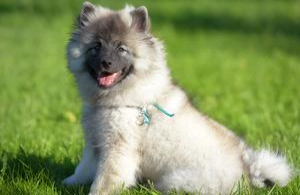
Keeshonds are the next dog breed on our list of dogs with black faces. The AKC breed standard for this breed is that their muzzles should be dark in colour. A Keeshond’s coat colour should be a mixture of grey, black and cream.
Adult males typically measure 17 to 18 inches (43 to 46 cm) at the shoulder, with females slightly smaller. Males generally weigh between 35 to 45 lbs (15.9 to 20.4 kg), while females range from 25 to 35 lbs (11.3 to 15.9 kg).
The name “Keeshond” is derived from the 18th-century Dutch political leader Cornelis (Kees) de Gyselaer, who was often associated with the breed. An alternative name for the Keeshond is “Dutch Barge Dog,” as these dogs were commonly found on canal barges in the Netherlands.
Temperamentally, Keeshonds are known for their friendly and outgoing nature, making them excellent family pets. They require about 30 to 60 minutes of daily exercise to keep them mentally and physically stimulated. These dogs are easy to train because they like being in the company of people. Health-wise, Keeshonds may be prone to certain conditions such as hip dysplasia and patellar luxation.

